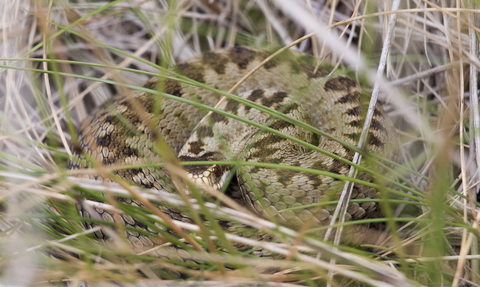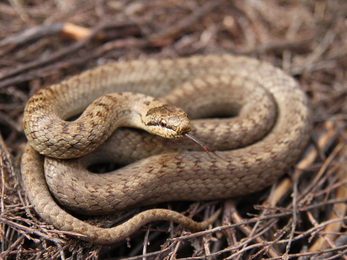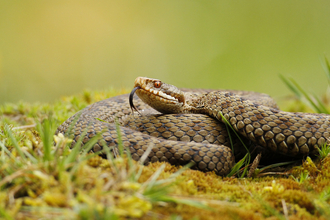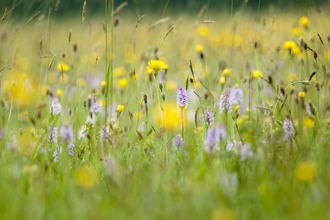
Adder - ©Chris Lawrence
Where to see a reptile
Lizards, snakes, and slow worms
Reptiles are found in a wide range of places, from sandy heaths and woodland ridges to garden compost heaps. Some of Britain’s six species of reptiles are now very rare, meaning that The Wildlife Trust’s work to restore and protect vital habitats has never been so important. Reptiles are fascinating animals that are aften sadly forgotten about when talking about interesting UK wildlife. Most lay eggs, but some give birth to live young, they live in an array of habitats and, contrary to general expectations, are often quite shy.
Native species
Explore the links below to learn more about our 6 native reptiles and how to identify them:
- Common lizard (http://live-twt-d8-national.pantheonsite.io/wildlife-explorer/reptiles/common-lizard)
- Sand lizard (http://live-twt-d8-national.pantheonsite.io/wildlife-explorer/reptiles/sand-lizard)
- Slow worm (http://live-twt-d8-national.pantheonsite.io/wildlife-explorer/reptiles/slow-worm)
- Grass snake (http://live-twt-d8-national.pantheonsite.io/wildlife-explorer/reptiles/grass-snake)
- Adder (http://live-twt-d8-national.pantheonsite.io/wildlife-explorer/reptiles/adder)
- Smooth snake (http://live-twt-d8-national.pantheonsite.io/wildlife-explorer/reptiles/smooth-snake)
Although views may often be fleeting, the sight of an adder’s diamond-patterned back or a sunbathing lizard will live long in the memory
Finding reptiles near you
Do a little research in advance and find out some of the best Wildlife Trust reserves to see different species of reptiles.
Alderney Wildlife Trust
Vau du Saou - The woodland of Vau du Saou is made up of a mix of deciduous native trees - including ash and elder - large conifers, and native bluebells, which combine to create a truly atmospheric place to go walking. The reserve contains the AWT’s Countryside Interpretation Centre, otherwise known as the “Wildlife Bunker”, which is held within the two-metre thick walls of a World War Two German bunker. It contains information and displays on the island’s wildlife and military history, and was the first such site opened in the Channel Islands. The Wildlife Bunker is open all year round.
Cornwall Wildlife Trust
Upton Towans - This nature reserve near Hayle has internationally important dune grasslands, which support a range of species including glow worm, pyramidal orchid and sky lark. The sand dunes rise steeply from the beach and provide a wonderful view of the stunning views across St Ives Bay. Adders can be found in the grasses on the dunes here and restoration work has recently been carried out throughout the reserve in order to ensure that the habitat is favourable for native reptiles.
Chûn Downs - The reserve is part of the West Penwith Moors, which overall, contain 25% of Cornwall's heathland. The Downs are largely scrub covered and would have been created by woodland clearance in the 3rd or 2nd centuries BC. Stunning panoramic views extend across the landscape of historic small fields, Cornish hedges and spectacular heathland to the sea. Reptiles have been recorded on site and are likely to be spotted basking in the sunshine and making their way through the heathland.
Beds, Cambs and Northants Wildlife Trust
Fulbourn Fen - The old meadows here have never been treated with pesticide or fertiliser, so they have kept the high diversity of plants and insects which traditional farming techniques produced. Six species of orchid have been recorded in the varied grassland lying over complex geology and archaeology, while the woods shelter the reserve and harbour birds and fungi.
Common lizards and grass snakes have been recorded on this site.
Berks, Bucks and Oxon Wildlife Trust
Snelsmore Common - contains a range of habitats including heather, wet bog and woodland making it home to a host of nationally rare species. There is a good chance of spotting adder, grass snake, common lizard and slow worm whilst visiting the site. A pond on the reserve also hosts breeding palmate newts.
Over 75% of lowland heath like Snelsmore has been lost and as a result many birds and other animals that inhabit heathland are nationally very rare. It was decided therefore to restore the heathland at Snelsmore Common through a combination of tree and bracken removal, and livestock grazing. This makes this reserve a really special place to visit so don't miss it!
Devon Wildlife Trust
Bovey Heathfield nature reserve is a real reptile haven – and is a rather unique nature reserve as it has been rescued from a trashed site of burned-out cars and fly-tipping to become a colourful lowland heathland of heather and gorse. Visit on a hot day and you have a good chance of seeing slow worms and common lizards basking on the patches of bare earth. Grass snakes and adders also make use of the many corrugated iron ‘reptile shelters’ that have been placed around the reserve. Look out too for the dragonfly ponds and the stonechats and green woodpeckers that can be seen on the woodland fringe.
Stapleton Mire is a Culm grassland site rich in nationally rare plant and insect species. The reserve was acquired by Devon Wildlife Trust from a farmer who had farmed the land in a traditional way for many years, thus maintaining the diverse site we see today. The Culm grassland communities are very rich and this reserve hosts a variety of wildlife, from roe deer and barn owls to marbled white butterflies. Adders have been recorded regularly on this site.
Rackenford and Knowstone Moors together with the adjacent Hares Down, represents the largest remaining block of Culm grassland in Devon, a habitat that was once widely distributed across the north of the county but, through changes in agricultural practice, has become greatly fragmented and localised. It is designated SAC and SSSI for marsh fritillary butterflies and Culm grassland (purple moor-grass pasture and wet heath). Adders and slow-worms can be found thriving in this rare grassland.
Dorset Wildlife Trust
Higher Hyde Heath - Nestled within one of the best areas of the country to see all six native British reptiles, this is an internationally important heathland site, with wet, dry and humid heaths, a selection of peaty pools and ponds, mire and wet woodland. Birds include the ground nesting nightjar, Dartford warbler, woodlark and tree pipit.
Many interesting dragon and damselflies live in the wetter areas, while grayling and silver-studded blue butterflies can be found on the open heath. See if you can spot all six species of reptiles on this wonderful site.
Essex Wildlife Trust
Stanford Warren Nature Reserve - This 41 acre Thames-side reserve consists of one of the largest reedbeds in Essex, created by gravel extraction in the 1920s, together with areas of marsh and rough grassland. Many bird species can be spotted here in the spring and summer using the reedbeds. Common lizard, grass snake and adder frequent the rough grassland, and harvest mice nest among the reeds.
Two Tree Island - Reclaimed from the sea in the 18th century when a seawall was built around the saltmarsh, the enclosed area has since been used for rough grazing and subsistence farming. The island is now bisected by a roadway that neatly divides it into two halves. Essex Wildlife Trust now manages the island as a nature reserve.
Birds such as green woodpecker, kestrel, short-eared owl, skylark, meadow pipit and fieldfare can also be seen. Slow worms, adders and common Lizard can be found throughout the grasslands. There are various walking routes around this reserve. Visitors are advised to keep to the marked tracks to avoid disturbing the birds.
Kent Wildlife Trust
Pegwell Bay - Kent Wildlife Trust's largest and one of its most important nature reserves, with the only ancient dune pasture in Kent. The reserve is made up of a complex mosaic of habitats: inter-tidal mudflats, saltmarsh, shingle beach, sand dunes, ancient dune pastures, chalk cliffs, wave cut platform and coastal scrubland.
The reserve is of international importance for its waders and wildfowl, best seen over winter or during the spring and autumn migrations. It may also be possible to spot the sand lizard at this reserve, using the important dunes for its home – this is a great spot as the sand lizard is very rare!
Northumberland Wildlife Trust
Holystone Burn is a varied reserve with habitats such as upland woodland and moorland vegetation, including oak and birch woods, scattered juniper scrub, areas of wet grassland, heathland, flushes with bog myrtle and a small reed bed. The site has two species of reptile – adder and common lizard – both of which are likely to be found throughout the lowland heath and wet grasslands where there are lots of undercover areas for them to hide.
Kielder Forest and Border Mires - Kielder Forest is part of the Living Landscapes project, which is concentrating on restoring the land in order to enhance it both for the people and the wildlife living there. The area consists 3,500 hectares of mires (bogs) and 50,000 hectares of forest. Restoring the mires to their natural condition will benefit rare species including long leaved sundew, small pearl bordered fritillary butterflies and breeding birds like merlin and curlew. Reptiles such as the common lizard have been spotted on site, and the restoration of the valuable bog areas will benefit this species greatly.
Annstead Dunes are an extensive and important part of the Northumberland coast. The area consists of a strip of mature sand dunes at the back of the bay between Beadnell and Seahouses. The foredunes at the seaward edge are up to 10 metres high and slope steeply to the beach below. The fixed dunes to the back vary greatly in height and are at their highest towards the southern end of the site, while at the northern end, near Annstead Bridge, they are lower than the foredunes. A colony of common lizards can be found on the dunes and are often seen sunbathing.
Whitelee Moor is one of Britain's most important upland nature reserves and is a site of European conservation importance due to its active blanket bog and heather heaths. A large part of the reserve is rare blanket bog, which is home to a variety of plants including sphagnum mosses, cloudberry, bog asphodel and cotton grasses. The site also includes heather moorland, rough grassland and acid grassland, with pockets of valley fen and a few calcareous habitats. Adder and common lizard are common here as well as palmate newts on small pools along the burn.
Ford Moss is a lowland raised peat bog set between farmland to the north and a sandstone ridge to the south. The raised mire is set in a hollow and has grown over a small lake which would have been present shortly after the last Ice Age. The aromatic bog myrtle grows in various places, and the site is home to good numbers of common lizards, with adders also seen on occasion.
Harbottle Crags - This nature reserve is an area of beautiful open moorland and includes the Drake Stone (an excellent viewpoint across the Coquet Valley), where nearby rocks have been scratched and polished by the ice sheet of the last glaciations. The site is largely covered by upland heather. The peat bog at the eastern end of the lough has formed from a layer of sphagnum moss growing over deep water. Adder, slow worm and common lizard have all been recorded on the site, favouring the heathland habitat.
Yorkshire Wildlife Trust
Allerthorpe Common Nature Reserve is a mosaic of habitat types – dry heath, wet heath, marshy grassland, mire, tall grass, bracken, ponds, broadleaved woodland and scrub. The lowland heath habitat found here once stretched right across the Vale of York, but now only remains in isolated fragments. This habitat and the wildlife it supports are now rare across the UK.
Patches of gorse scrub provide shelter for birds and their network of roots support a healthy population of adders. Visit on a sunny morning between February and April and you are almost guaranteed close-up views of basking adders. Other reptiles which can be found on the reserve are common lizards and slow-worms.
Strensall Common is a fabulous large heathland close to York where the pink heads and grey-green leaves of cross-leaved heath intermingle with the purple spikes and green foliage of ling heather. This site is of international importance and holds SSSI and SAC status. Silver birch have been cut back to maintain the open nature of the heathland and this is where you can find common lizards basking on the birch stumps in the sunshine.
Fen Bog - Surrounded by bright purple heather, with a variety of colourful sphagnum mosses underfoot, Fen Bog is a delightful moorland nature reserve. Besides controlling bracken by hand, the site is grazed by sheep from neighbouring common land. This is beneficial in keeping down coarse grasses that may threaten some of the plant species present such as heather and hard ferns.
The Lyke Wake Walk from Osmortherly to Ravenscar is where you can discover both adders and common lizards, which bask in the sunshine. There are not just reptiles on offer here – this site has so much more for nature enthusiasts. The site is renowned for butterflies like the small pearl-bordered fritillary and bog plants such as round-leaved sundew. Meadow pipit breed here and you may even spot merlin passing through.
Potteric Carr Nature Reserve - Nature paths suitable for wheelchairs and pushchairs will wind you around a stunning, safe wetland habitat littered with pockets of woodland and wildflower meadows. The ponds provide a home for newts, frogs and whirligig beetles with staff on hand to show you the best spots for pond dipping.
This is a great place to see grass snakes and a visit early in the day (before other visitors have scared them off) is the best time. You can see snakes of all sizes in the ponds in Loversall field or along Loversall delph. The months between April and August provide the best weather conditions for the snakes and you are very likely to spot one or two during this time.
What to look for
Make sure you do not touch or disturb these bewitching creatures. When the sun is out and the temperatures are rising is the best time to see reptiles as they bask in open areas. Check under the corrugated iron mats left for reptiles at many reserves to see if a slow worm, lizard or snake is lurking underneath.
If you can't get to these places
Don’t worry if you can’t make it to one of these sites as reptiles can be found even in towns and cities. Check out our guide to creating a haven for reptiles wherever you live.
More wildlife experiences
From seeing colourful wildflowers to spotting magnificent birds of prey, we can help you get closer to wildlife across the UK.








